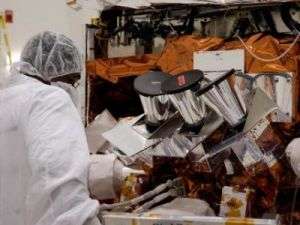NASA's GLAST gets shades, blankets for the beach

GREENBELT, Md. - NASA's Gamma-ray Large Area Space Telescope, or GLAST, is receiving finishing touches at the Cape Canaveral Air Force Station, near the beaches of eastern central Florida for its launch. The spacecraft is set for launch aboard a Delta II rocket no earlier than June 3. The launch window runs from 11:45 a.m. to 1:40 p.m. EDT.
Housed at the Astrotech Facility located near the Kennedy Space Center, Fla., GLAST is getting a lot of attention from engineers and scientists, from sun shades to thermal blankets, to final inspection.
Recently, sun shades were installed on GLAST. "These are light shades on the star tracker optics (optics that measure where the observatory is pointing) that keep light outside of the field of view from obscuring the star field," said Al Vernacchio, GLAST Deputy Project Manager at NASA's Goddard Space Flight Center, Greenbelt, Md. "Sun shades are like a visor you flip down in your car on a sunny day to block the Sun's glare so you can see the road," said Steve Ritz, GLAST Project Scientist at Goddard.
They "shade" the star tracker field-of-view from stray light coming from the Sun, the Earth and the Moon, so GLAST's star trackers can see the needed reference stars. GLAST uses reference stars to check its orientation. Basically, GLAST is navigated using both GPS and the stars.
Once the shades are installed, temporary covers are placed on the open part of the shades to protect the optics from debris. These covers are removed after the rocket fairing (shell of the rocket where GLAST will sit) is installed on the launch vehicle prior to flight.
Thermal blanket "closeouts" were also recently done at Astrotech. Basically, thermal blankets are to spacecraft as clothes are to people. They'll protect GLAST from the harsh environment of space. A "closeout" means taping up all the loose seams on the insulation. The seams are always left open as long as access to the spacecraft is needed.
Engineers also made sure that GLAST had a thorough cleaning and a "blacklight inspection." The cleaning/blacklight inspection is just what it implies - going over everything carefully. "The blacklight can help with the cleanliness inspection, especially in finding organic materials like fingerprints which fluoresce (and become visible) under the ultraviolet from the blacklight," said David Thompson, a GLAST Deputy Project Scientist from NASA Goddard.
On May 4, workers moved the GLAST spacecraft to the Hazardous Processing Facility near Kennedy Space Center, Fla. for fueling.
Currently, the Delta II launch vehicle that will carry GLAST spaceward is also being prepared on Launch-pad 17B.
GLAST is a powerful space observatory that will explore the most extreme environments in the Universe, where nature harnesses energies far beyond anything possible on Earth. It will search for signs of new laws of physics and what composes the mysterious dark matter, explain how black holes accelerate immense jets of material to nearly light speed, and help crack the mysteries of the stupendously powerful explosions known as gamma-ray bursts.
Source: Goddard Space Flight Center





















